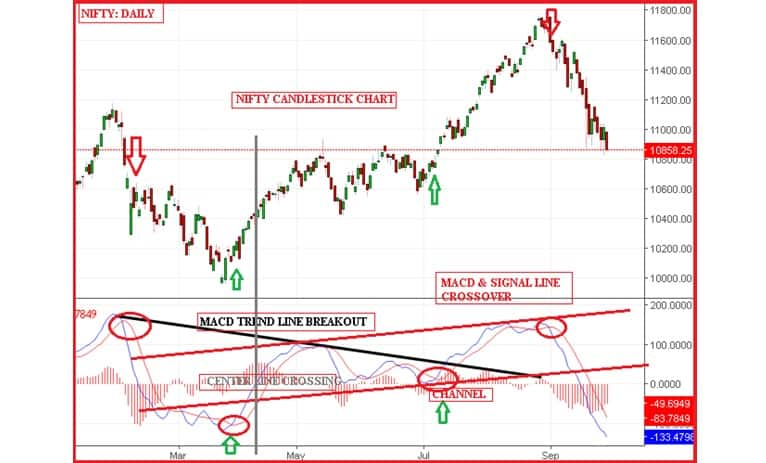



The MACD indicator is one of the most popular tool in technical analysis because it gives traders the ability to quickly and easily identify the short-term trend. Even short term momentum changes can be easily observed using the MACD indicator.
What is a ‘MACD Indicator’?MACD is one of the simplest and most effective momentum indicators available. Gerald Appel developed this indicator in the 1970s, however ThomasAspray added the histogram feature to Apple’s MACD in 1986 and although its name sounds very complicated, it's really quite simple to use.
As the moving averages separates from each other, the histogram gets wider. This is called divergence because the faster moving average is “diverging” or moving away from the slower moving average.
As the moving averages get closer to each other, the histogram gets smaller. This is called convergence because the faster moving average is “converging” or getting closer to the slower moving average.
And hence name of this indicator is MovingAverage Convergence Divergence. It can be MACD can be pronounced as either “Mac-Dee” or “M-A-C-D.”
 Figure1. MACD indicator
Figure1. MACD indicator
Specifically, the value for the long-term moving average is subtracted from the short-term average, and the result is plotted onto a chart. The MACD is calculated using the following formula:
 Figure2. MACD Indicator Formula
Figure2. MACD Indicator Formula
A positive MACD value, created when the short-term average is above the longer-term average, is used to signal increasing upward momentum. This value can also be used to suggest that traders may want to refrain from taking short positions until a signal suggests it is appropriate.
On the other hand, falling negative MACD values suggest that the downtrend is getting stronger, and that it may not be the best time to buy.
Trend & MACDThis tool is used to identify moving averages that are indicating a new trend, whether it's bullish or bearish. After all, top priority in trading is to find a trend, because that is where the most money is made.
As a result, the MACD offers the best of both worlds: trend following and momentum.
Overbought / Oversold LevelsBecause the MACD is unbounded, it is not particularly useful for identifying overbought and oversold levels.Even though it is possible to identify levels that are historically overbought or oversold, the MACD does not have any upper or lower limits to bind its movement. During sharp moves, the MACD can continue to over-extend beyond its historical extremes.
Traders will often combine this analysis with the Relative Strength Index (RSI) or other technical indicators to verify overbought or oversold conditions.
Drawbacks of MACDTrading Technique:
The Centerline- As mentioned earlier, the MACD indicator is calculated by taking the difference between a short-term moving average (12-day EMA) and a longer-term moving average (26-day EMA).
Given this construction, the value of the MACD indicator must be equal to zero each time the two moving averages cross over each other. Since this is non limiting indicator zero means ‘center line’.
One can easily understand about positive crossover of 2 EMA on price means positive MACD (above center line). However this signal can be used for buying purpose and vice versa.
Channeling the MACD - The practice of drawing trend lines on a stock chart is as almost as old as buying stock itself, but one can also draw trend lines on the indicators.
Drawing a support and a resistance level at the same time creates a channel of action that helps measure the trend's current strength. The strength of the current trend can be measured by channeling the MACD.
One can use trend lines as well on MACD, and trend line breakouts can justify as a buy signal too.
 Figure3. MACD Indicator Buy & Sell Signals
Figure3. MACD Indicator Buy & Sell Signals
Signal Line Crossovers- Signal line crossovers are the most common MACD signals used in trader's world. The signal line is a 9-day EMA of the MACD line. As a moving average of the indicator, it trails the MACD and makes it easier to spot MACD turns.
A bullish crossover occurs when the MACD turns up and crosses above the signal line. A bearish crossover occurs when the MACD turns down and crosses below the signal line. Crossovers can last a few days or a few weeks, it all depends on the strength of the move.
When the two MACD indicator lines move away from each other, it means that momentum is increasing and the trend is getting stronger. When the two lines are coming closer to each other, it shows that price is losing strength.
Divergences- MACD divergence is similar to other oscillator divergences. And it forms when the MACD diverges from the price action of the underlying security.
A bullish divergence forms when a security records a lower low and the MACD forms a higher low. The lower low in the security affirms the current downtrend, but the higher low in the MACD shows less downside momentum.
 Figure4. MACDPositive & Negative Divergences
Figure4. MACDPositive & Negative Divergences
Despite less downside momentum, downside momentum is still outpacing upside momentum as long as the MACD remains in negative territory. Slowing downside momentum can sometimes foreshadow a trend reversal or a sizable rally.
ConclusionDiscover the latest Business News, Sensex, and Nifty updates. Obtain Personal Finance insights, tax queries, and expert opinions on Moneycontrol or download the Moneycontrol App to stay updated!
Find the best of Al News in one place, specially curated for you every weekend.
Stay on top of the latest tech trends and biggest startup news.